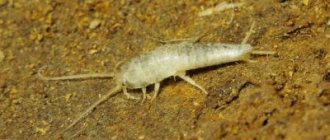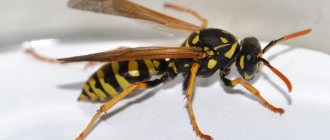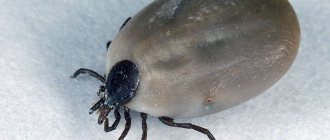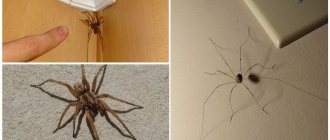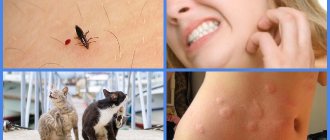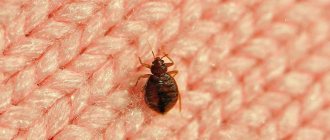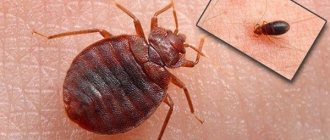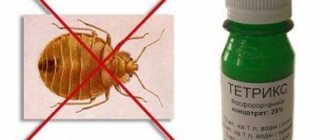Systematic position of woodlice
| Categories used for scientific taxonomy of the parasite | Category names | |
| Basic taxonomic | Domain | Eukaryotes, nuclear organisms |
| Squad | Isopods | |
| Class | Crustaceans, crayfish | |
| Type | Arthropods | |
| Kingdom | Animals | |
| Chapter | Bilaterally symmetrical | |
| Intermediate | Sub-kingdom | True multicellular animals |
| Subsection | Protostomes | |
| Supertype | Multi-segment, polymer | |
| Subtype | Crustaceans | |
| Subclass | Higher crayfish, malacostraca | |
Description of woodlice
By the way, almost everyone who has studied biology for a long time is sure that woodlice is an insect.
Meanwhile, woodlice is a representative of the class of crustaceans, an order of isopods. That is, she is the closest relative of crayfish and crabs. Woodlice should not be confused with silverfish insects. The body of the woodlice is convex, consisting of small segments, the eyes are located on the side, and the outer antennae are almost equal to the length of the body. Some species have designs on their backs similar to oriental hieroglyphs. The shell is divided into segments, each of which has legs. When in danger, they pretend to be dead, curling up into a ball.
She bears offspring in the folds of her abdomen; after the eggs turn into living individuals, they come out. The lifespan of woodlice is from 9 to 12 months.
There are 4,500 species of these isopod crustaceans, which have adapted to survive in different conditions. Woodlice are found in all climatic zones of the planet.
They live on land, but in damp places. During the day they hide in shelters, and in the evening and at night they go in search of food.
Woodlice feed in the house on plant debris - plant roots, flower stalks, new shoots. In nature, these are tree bark, algae and moss. After a feast of woodlice, holes can be found on the leaves of plants, but only on the outside; they do not move on the inside.
Calling woodlice an insect or beetle is completely incorrect. They are crustaceans, essentially tiny crustaceans. Their appearance has the following features:
- An oval, convex body at the top, covered with hard, hard shields, like an armadillo. In our country there are gray and light gray woodlice with a greenish tone. The standard size of mature individuals is 0.5–1.5 cm. 2 cm is the longest length of the common woodlice.
- 2 pairs of antennas consisting of several segments. The first pair of antennae, in contrast to the second, are small and poorly developed. Based on the fracture and length of the woodlice's nests, their belonging to one species or another is determined.
- The eyes are located on the sides of the head.
- Mandibles lack tentacles.
- Eight thoracic segments, the first of which covers the sides of the head, the last has a deep notch at the back.
- 7 pairs of legs adapted for movement. The first 5 pairs of legs cover each other like tiles. Their inner branch serves as gills, and the outer branch serves as a lid. The solid outer branch of the first pair of limbs contains air cavities that open outward. The sixth pair of legs is turned backward and protrudes between the fifth and sixth abdominal segments.
Woodlice are quite large in size, so they are easy to notice if they have settled in the house. You can see what these creatures look like in the photo. Below is also a diagram of their structure.
The weed has several names, although the popular definition of “woodlice” fully corresponds to its essence. This is due to the plant’s commitment to shaded areas of soil with good moisture. If the soil is also fertile, then in the warm months the woodlice reproduces very actively. The weed is famous for its vitality and high degree of adaptability.
Cultivated species cannot withstand competition and are often quickly suppressed by their harmful neighbor. The thin, highly branched stems of the weed retain moisture (dew) well, which is why the plant received such an interesting name. This ability also allows the grass to survive dry periods.
Scientists classify the chickweed grass as a member of the clove family and define it as “average chickweed” or Stelláriamédia. This is an annual herbaceous plant with small flowers resembling stars in outline.
It blooms in spring and summer, usually from May to the end of August. Seeds are formed in boxes. They can be either kidney-shaped or round in shape. Like any weed, woodlice produces a lot of seeds. Up to 15 thousand of them can ripen on one plant. The seeds retain their viability for 5 years.
Woodlice reproduces vegetatively. Any part of the stem takes root and forms a new plant.
Characteristics of the weed that describe its features:
- Seeds germinate when the temperature rises to 3 °C. Therefore, already in early spring you can find green woodlice shoots at different ends of the site.
- The weed has a long growing season; woodlice retains green shoots until the first frost.
- Nodules form on the growing stems, which take root very easily and allow the plant to quickly conquer new areas.
- The ephemeral develops within a month, then dies. At this time, still living nodules or fallen seeds become new plants. The productivity of the weed is very high. Woodlice does not have a rest period.
Important! If there is a wood lice in the area, you need to be extremely careful. Even a small piece of shoot, carelessly thrown onto the ground, produces new full-fledged stems.
There is another popular name for the weed - bird's lettuce. Feathered pets eat chickweed with great pleasure. This suggests that the plant contains many useful components.
What are the types?
There are 3,000 subspecies of woodlice. They are all similar in appearance and lifestyle. The living space is occupied by only 2 types of representatives, which are described in the table.
| Common woodlouse | The body is covered with a gray or brown shell. The length does not exceed 1.5 cm. When in danger, it curls up into a tight ball. Woodlice dies when air humidity drops below 80%. |
| Cellar woodlice | The shell is gray. The shell is rough to the touch. The length does not exceed 2 cm. The creature often lives in cellars. When in danger, the woodlice does not curl up into a ball, but begins to run. |
The listed species live in human dwellings or various buildings. They are able to start in an apartment, even if a major renovation has recently been carried out. The main thing is the availability of favorable living conditions.
Why are wood lice not hatching in the apartment?
The most common places where woodlice are found in an apartment are the kitchen and bathroom, due to the constant presence of two factors:
- High humidity. The accumulation of condensate is an ideal condition for the development of crustaceans;
- Availability of food. A trash can is an optimal environment in which food waste necessary for life is constantly present.
In addition to the listed places, woodlice can be found in flower pots, where there is not only a humid environment, but also fallen leaves. The main condition for the development of uninvited guests is high humidity, therefore, eliminating this factor will get rid of woodlice.
There are also benefits from wood lice, but they are insignificant. They can feed on spores of pathogenic fungi on crops, thereby keeping the plants alive. By feeding on rotten plants, vegetables and fruits, wood lice produce mineral fertilizer in the soil with their feces.
After completing all measures to combat crustaceans, it is recommended to follow a number of recommendations that will prevent their occurrence in the future:
- regular and thorough cleaning of the bathroom and kitchen;
- eliminating indoor humidity;
- cleaning and treatment of ventilation;
- regular ventilation;
- use of heaters, air conditioners and other devices that control humidity levels;
- sealing cracks in the flooring, near baseboards;
- monitoring the serviceability of water communications.
By following these simple recommendations, you can protect yourself and your home from the penetration of unwanted “inhabitants”.
The destruction of woodlice in an apartment is an important undertaking. They do not bite animals or people, but if they are not removed, the consequences can be extremely dire.
It has been proven that wood lice in the house are carriers of various diseases; they spread lichen and fungus throughout the premises, thereby causing enormous damage to human health.
Many people feel disgust at just one glance at a repulsive and unpleasant insect, and constant contact with them, for example, if woodlice appear in the bathroom every time you turn on the light, can cause stress and a nervous breakdown.
1. A time-tested and practice-tested remedy - boric acid. It has a destructive effect on the chitinous cover of crustaceans, thereby killing them. The solution should be sprayed in places where insects accumulate.
2. In one liter of water you need to dissolve three grams of soda ash, tobacco powder and red pepper. The mixture is sprayed where pests have accumulated.
3. Spraying agent - a simple solution of half a liter of boiling water and one hundred grams of dry kvass. In the bath, toilet or kitchen, the solution is sprayed along the baseboards, into various cracks, and in the corners of the floor. In the bathroom it is better to treat the ceilings as well. The room is closed for 8-10 hours, after which it is washed with plain water.
4. The destruction of woodlice in an apartment or in an open area is carried out using traps. To do this, you need to take a damp birch broom, wet moss or a rag, and place the objects near the parasites’ habitat. At dawn they will definitely crawl there, after which the bait must be shaken over the container. Chickens love to eat insects, and you can pour boiling water over them or burn them at the stake.
5.The following trap is effective for killing woodlice in flower pots and cellars. You need to cut out the middle of a carrot or potato, they will certainly get in there, and in the morning they are destroyed along with the bait.
If safe folk remedies do not help, you will have to use chemicals.
Leading scientists in our country have developed means that massively destroy insects, including wood lice. There are means and baits “Mole” and “Gett”. The composition should be applied to the floor of the bathroom or toilet, then left to dry for 48 hours. After 5 days, the treatment must be repeated, this guarantees the complete disappearance of unpleasant neighbors.
Tarax powder is highly effective. The product destroys almost all types of insects. One package is enough to treat sixty square meters of surface. The powder is dissolved in 250 ml of water; the solution must be treated with pipes, baseboards, ventilation shafts, and other places where woodlice accumulate.
Universal products with maximum effect – “Schabengel” bait – gel, “Varan” spray, “Tetrix”.
Treating the soil in autumn and spring with insecticides “Grom”, “Aktara”, and “Ideal” will help get rid of woodlice in the garden. The soil should be constantly loosened, providing oxygen access to the roots of the plants. To avoid spoiling the harvest, it is better to spray the bushes with a soap solution prepared in a ratio of 100 grams of laundry soap (finely grated) per ten liters of water.
When using pesticides, you must follow the rules for their use. Protective equipment is required - rubber gloves and a respirator. After treatment, hands and face should be washed with soap.
Scientists entomologists have discovered that woodlice are highly resistant to insecticides. In addition, a humid environment is ideal conditions for them, which means emulsions, liquid concentrates, and wet treatments will not be effective. They eat organic waste, meaning they can eat bait gels. The food method of destruction in this case is most relevant.
In general, resistance, that is, the resistance of organisms to biological and chemical drugs, is inherent in many insects. Female woodlice are resistant to drugs because they are larger than males. Many insects become resistant as a result of too frequent treatments. Thus, the number of individuals decreases, but quickly recovers. The females survived, and therefore their offspring are already resistant to one or another type of insecticide.
The appearance of woodlice will be prevented by cleanliness in the apartment, good ventilation and moderate humidity. But, depending on the circumstances, even following all recommendations and rules, as well as using high-quality products, will not help get rid of pests. Then the help of professionals will come in handy, because simultaneously with the destruction of woodlice, their larvae must also be eliminated.
And yet, you should not purchase disinfectants and insecticides in the markets; there are specialized stores for this. Many of these drugs, bought secondhand, are unsafe and do not have certificates.
Those who are faced with the appearance of these disgusting creatures in their home are interested in the question of whether it is possible to suffer from their bite. This multi-legged inhabitant of the home does not bite and does not secrete poison, therefore it is not capable of causing harm to humans. All types of these creatures are not poisonous. However, they taste quite unpleasant.
Comprehensive measures to combat woodlice
If the number of woodlice does not decrease, but increases, they begin to appear beyond the boundaries of their permanent residence even during the daytime, then you will have to engage in a merciless fight against them, and the measures must be comprehensive:
- The accumulation of dampness and humidity in the bathroom should be prevented (or, if possible, reduced): remove all debris accumulated under the bathroom, thereby depriving wood lice of housing.
- Clean and adjust the existing ventilation system or install forced ventilation.
- Check the condition of pipelines, especially butt joints, throughout the house (apartment). If the pipes are metal, replace them with plastic ones if possible. There will be less condensation deposited on them.
- Seal all cracks in the house (apartment) through which parasites can get inside.
- Use insecticides targeted, that is, intended specifically for woodlice. You can use the help of professional exterminators.
Woodlice - an insect or crustacean, where it lives, what it eats
According to various sources, in nature there are 3500-5000 species of these small crustaceans: armadillidiidae (armadilla), porcellio scaber (porcella, or mumps), Reaumur woodlice, etc. The following types of woodlice can be found on the territory of our country:
- Common woodlouse armadillo. These owners of a dark, high shell are rarely found in residential areas. They usually live in basements and cellars.
- Woodlice is rough. This type of crustacean has a soft, flattened shell that is greyish, yellowish, reddish or almost black. Unlike the armadillo woodlice, the common woodlice moves quickly. They are able to deftly move between floors in apartment buildings. This woodlice can rightfully be considered domesticated.
| Ingredients | Preparation | Application |
| Boric acid | Dilute 20 g of acid in 1 liter of water. | Spray the solution in areas where animals are most concentrated, then limit the water supply to the home for 24 hours. |
| Bleaching | Mix 20 g of powder with 1 liter of water. | Treat the entire apartment around the perimeter with the product, paying special attention to joints, corners and hard-to-reach areas. |
| Tobacco, soda, ground red pepper | Mix the components in equal parts. Pour a small amount of boiling water over the mixture. | Spray the liquid in areas where the creatures are most concentrated. After 1.5–2 hours, treat the application areas with a weakly concentrated bleach solution. |
Pests belong to the suborder Crustaceans from the order Isopods. They are descendants of ancient arthropods that emerged from the water. Modern woodlice are not sufficiently adapted to life on land; they prefer rather damp places.
Although some species can live in deserts or very salty bodies of water, it is the species that makes its way into our apartments that loves dampness.
Such crustaceans are found in nature in shaded places saturated with moisture. They are localized mainly in wet crevices, in the ground under awnings, in heaps of garbage or rotting leaves. They also like to live under rocks or fallen tree trunks.
In populated areas, crustaceans settle in wooden houses with areas of rotten walls and floors. They can be found in cellars and basements. From there, pests scatter over considerable distances and can settle in an apartment with high humidity or leaking pipes. Their favorite places are flower pots and greenhouses.
They are classified as detritivores. This means that pests eat mainly dead tissues in which the process of decomposition has already begun.
Main habitats in the house and apartment
The appearance of woodlice in the house is always a big surprise, but if you wish, you can predict their appearance, because the number of their habitats is very limited. Woodlice live in residential areas:
- In bathroom;
- in the toilet;
- in ventilation shafts;
- near or inside sewer pipes;
- under the window sills;
- near trash cans;
- under the baseboards.
By keeping these areas relatively clean and dry, woodlice infestations can be easily avoided.
Under the bath
The bathroom is one of the main sources of dampness. The air humidity in this room is several times higher than in other rooms, which attracts woodlice there like a magnet. In addition, wet towels and other things are usually stored in the bathroom. All these factors together create comfortable conditions for the life and reproduction of insects.
Behind the toilet in the toilet
The toilet is another place where wood lice are most comfortable to exist. The problem is complicated by the fact that there is a sewer pipe in the toilet, which creates additional humidity. The appearance of woodlice in the toilet is common.
Behind the sewer pipes
As mentioned above, sewer pipes are a favorite habitat for woodlice. It is always humid next to them, there is something to eat, and the owners practically do not look under them, allowing the insects to feel safe.
In the ventilation ducts
Ventilation ducts in apartments and houses are rarely cleaned and are not checked for the presence of woodlice. But darkness always reigns in them, which, combined with humid air from the kitchen and bathroom, creates “resort conditions” for insect pests.
Under the windowsill
The space under the window sill, at the junction with the wall, is another potential refuge for woodlice. There are always small gaps through which woodlice get out in the dark, crawling around the apartment in search of food.
Inside sewer pipes
A problematic place that is difficult to check for pests. There is always something to eat there, and the air is damp and musty. Woodlice can move through pipes from one apartment to another without being noticed.
Near the trash can
Garbage bins constantly attract many insects and animals, as a lot of organic matter accumulates in them. And if animals do not have access to household garbage cans, then it is difficult to stop woodlice. In addition, most housewives install a trash can under the sink, where the humidity is always higher than normal.
Under the baseboards
The space under the baseboard is the favorite place of all insects, and wood lice are no exception. Once a small gap appears in the joints, woodlice will happily sneak into such a secluded place. If there is an insect infestation in your apartment, do not be lazy to check the baseboards.
Where do woodlice come from?
Many people have encountered woodlice. Someone meets them while clearing out stale garbage from the site, and someone can see the crayfish when they go down to the cellar. They live under fallen leaves, in humus. They need moisture, woodlice in the apartment settle in places where dampness accumulates - the bathroom, toilet, kitchen, basement and attic.
If woodlice have settled in an apartment, how to get rid of them and where to look for habitats is a top priority. First of all, you need to inspect places where water accumulates, basements, baseboards in the kitchen, under the rug in the bathroom, under pipes, in closets with stale linen, on damp books, under the sink. Is there any leaking plumbing, or is there any garbage lying for a long time in a secluded place? They are often attracted to moist soil in flower pots.
Before you destroy wood lice in your apartment, you need to find out where they came from in order to block the paths of further spread.
In apartment buildings, insects often enter the premises through ventilation grilles, through sewer pipes; if they do not like the conditions (the room is dry), wood lice do not even linger in the bathroom or toilet, but go to look for the most favorable housing.
On the top floors, woodlice appear in the apartment, descending from the attic. Therefore, it is a good idea to check the attic space as well.
In a private home, close attention should be paid to greenhouses and greenhouses, where they end up with humus. In the cellar, the cause of their appearance may be rotten vegetables. In the garden - these are broken bricks, cuttings of branches, stones, rotting leaves. And in each case, the recipe for how to deal with woodlice is individual.
Are they dangerous for humans?
There is an opinion that wood lice are completely safe and do not need to be removed. The animal is not poisonous and does not bite. However, the crustacean negatively affects the sanitary condition of the apartment.
Before entering the apartment, the woodlice visited damp rooms and came into contact with the feces of birds and rodents. After this, the animal is able to crawl through places where homeowners prepare food.
Woodlice can be eaten by animals. A pet that is used to eating well may become poisoned after eating such a treat. You'll have to visit the vet.
At home, woodlice can destroy all indoor plants, as well as vegetables stored in the basement.
Woodlice can destroy the entire stock of vegetables
Woodlice - an insect or crustacean, where it lives, what it eats
Studying the lifestyle of such a “neighbor” is extremely important. Knowledge of how they reproduce, how long they live on average, and what these crustaceans eat will help prevent their appearance in a private home or city apartment. Using information about the habitat of these creatures (which are not insects), you can quickly and effectively deal with them, without resorting to the help of strong chemicals.
The reproduction of these creatures does not depend on the time of year. However, the eggs only develop when the female is not in suspended animation and is well fed. Mating in woodlice lasts a very long time. After the female molts, her spermatic receptacle opens only for a limited time, so the male finds and waits in advance for a partner for mating in a certain position.
Fertilized eggs enter a special brood pouch, located on the abdomen of the female individual near the last pair of legs and somewhat similar to the ooteca of cockroaches. In this reservoir they are abundantly supplied with liquid from special glands and are ventilated thanks to its open front edge. The eggs hatch into larvae. The larva differs from the woodlice imago only in size and the underdeveloped last pair of limbs.
After a few days the larva molts. The duration of development of the egg and larva depends on the type of crustacean. On average, each stage lasts from 30 to 35 days.
These are the only crustaceans leading a land lifestyle, and only a few species have returned to the aquatic environment. Woodlice appear in close proximity to their food supply. In the natural environment, they are found in dead wood, damp soil, at the roots of trees, and under stones. They can be found anywhere it is damp and cool.
The optimal conditions for the existence of most varieties of these tiny crustaceans are 25-degree temperatures and 95 percent humidity. These are nocturnal creatures. During the day they prefer to hide, going out in search of food at night.
These creatures are detritivores, that is, they eat organic matter with signs of decomposition. The basis of woodlice's diet in nature consists of plants, which often decompose. In the home, she eats leaves of indoor flowers, dust and mucus accumulated in the corners of the bathroom and toilet, and food debris. Nutrition in the life of these parasites does not play as important a role as water. Moisture is vital for them. If it is not there, they will not be able to wet their gills and will die from suffocation.
Natural enemies
These creatures are afraid of the heat-loving spider from the family Dysderidae - their main natural enemy. Toads, lizards, rats, shrews, and hedgehogs are also not averse to eating them. All of them are facultative enemies of woodlice and eat them mainly when they are immature. The body of these arthropods releases large amounts of nitrogen, which repels most species of birds, so they rarely decide to profit from such odorous food.
How to breed and keep woodlice at home?
There are situations when there is a need to maintain and breed woodlice. They serve as excellent food for small amphibians and additional feeding for lizards. There is no need to care for them, but it is necessary to create comfortable conditions for reproduction. A terrarium or a plastic container with a height of 20 to 30 cm, the bottom of which is heated, is suitable for this purpose. Its bottom should be filled with peat mixture, and 2-3 layers of turf should be placed on top.
You need to put a flat small container with food in the box. Its inhabitants can be fed with bran, oatmeal, gammarus, and crushed eggshells. Wet food (vegetables, fish) can be placed directly on the turf. From 15 to 30 wood lice populate the prepared terrarium.
When young individuals appear, tree bark should be placed on the turf, from which the woodlice are subsequently shaken off. Another method of collecting insects: make a vertical hole in the turf and place a glass cup in it so that the upper edge is 0.5 cm below the level of the turf. The individuals that fall into it are moved to animal feeders 2 times a day.
Types of crustaceans
Following a number of rules will help prevent uninvited guests from appearing in your home:
- wipe all wet surfaces dry after taking a bath or shower;
- prevent pipe leaks;
- close the tap tightly after use, change rubber seals in a timely manner;
- prevent food leftovers from rotting;
- monitor the condition of indoor flowers, cutting off dead parts in a timely manner.
The main preventative work to combat the weed begins in the spring. Woodlice stands out well with its bright green appearance among other plants that have not yet recovered from winter.
Necessary:
- It is good to loosen the area with a rake. This will help disrupt the weed's root system and prevent it from rising. It is important to do this immediately after the onset of heat.
- Be sure to remove the entire plant, and not just remove the above-ground part.
- Use proper and sharp garden tools – hoe, flat cutter, extractor.
- Destroy all parts of the weed without exception. The high reproductive capacity of woodlice will allow the weed to be reborn even from small pieces of shoots or roots.
- In the fall, dig up the areas where the weed was located. This needs to be done using a pitchfork and several times. Be sure to destroy all woodlice remnants.
These methods are not difficult, especially in small areas. If you use them regularly, the amount of weed will be significantly reduced. You can also regularly prepare medicinal decoctions and teas from woodlice so that the weed population does not increase.
Have wood lice appeared in your apartment? It's all due to excess humidity. The fight against woodlice in an apartment begins with removing moisture, because crustaceans breathe with gills and need moist air. In addition, it is necessary to limit their access to food. Each room needs to be regularly ventilated, and more attention should be paid to ventilation in the bathroom, bathroom and kitchen.
Indoor flowers affected by woodlice need to be replanted. Wash the roots of the plant and treat with a solution of potassium permanganate. It is not recommended to reuse old pots, even after treatment.
Those who live outside the city often wonder if there are wood lice in the house - how to get rid of them in the cellar and basement? In this case, good ventilation is also effective. Humidity will be reduced by quicklime placed in special containers or simply scattered on the floor. In the room, it is good to sprinkle salt in the corners or make a saturated saline solution and spray it. Empty containers and rotten fruits and vegetables should not be left in the cellar, as this will attract even more woodlice.
How to get rid of woodlice in the garden? You also need to put things in order on your personal plot: get rid of fallen leaves, fragments of bricks and stones, cuttings of trees and branches, pieces of polyethylene and other debris.
In greenhouses and greenhouses, it is advisable to dry the soil and carry out moderate watering.
There is no point in getting rid of crustaceans in the garden. There they carry much more benefit than danger. But there are places where pest control is necessary.
In a private house
First of all, it is important to reduce the humidity in the room and carry out thorough cleaning. Colonies of crustaceans signal that there is a serious leak or rot somewhere. In this case, repairs cannot be avoided.
Next, you should block pests’ access to the house. To do this, place strips of salt one and a half centimeters wide at door and window openings. Moving through them, the crustaceans become dehydrated and do not go further. It is also necessary to seal even the smallest cracks in the walls.
Without these measures, it will not be possible to remove uninvited guests. Only after the premises have been put in order can insecticides be used. The most effective ant repellents.
In the greenhouse
First you need to check whether the plants are watered too much. Waterlogged soil attracts pests and is not always beneficial for crops. The next step should be cleaning the area. You should get rid of wet boards and logs, collect garbage in closed containers, and cover manure heaps and composts.
Experienced gardeners use:
- tobacco
- soda
- ash
- ground red pepper
In the cellar
To eliminate excess moisture, good ventilation and regular airing are necessary. Quicklime or salt is scattered in the corners. You cannot store empty containers in the cellar. Vegetables and fruits must be clean and dry. They are regularly sorted to remove rot in a timely manner.
Woodlice can be collected using traps. To do this, potatoes or carrots with the core cut out are left in places where they accumulate. A damp rag or birch broom will also work. The crustaceans will get into the bait, and in the morning it will be enough to take them outside and destroy them. A similar trick will work in a greenhouse.
It is not difficult to understand that pests have settled in pots. The soil dries quickly and becomes compacted. When loosening, you can see white larvae. In this case, plants will need to be replanted. The roots are freed from the soil and washed in a weak solution of potassium permanganate. The seedlings are transferred to a new location, and the damaged pots with soil are thrown away.
In the future, you need to make sure that the containers have enough drainage holes. By the way, if there are not too many crustaceans in the seedlings, there will be more benefit from them than harm.
What chemicals are used to combat
There are several types of chemicals that can be used to control pests. Concentrated solutions are sprayed where there are the largest numbers of woodlice. The substances remain effective for several months after treatment.
The following drugs are considered the most effective:
- Tetrix;
- Delta.
The preparations are convenient to use in the form of aerosols. The product does not require preparation before use. Before use, be sure to read the instructions.
Insecticidal pencils are less effective. A significant advantage is the ability to use both horizontal and vertical surfaces. The poison easily penetrates the pest’s body due to the absence of a protective layer.
The most inexpensive way is to use poison in powder form. The method is approved for use only in the absence of pets. The poison is simply scattered on the floor, especially in places where wood lice accumulate.
You can fight them using special aerosols
Preparations in the form of gels are applied to any surface. The chemicals are safe for others and highly effective. Already 2 weeks after application, the animals actively disappear.
Effective drugs include:
- Fas;
- Absolute.
Chemicals can be purchased at any hardware store.
The benefits and harms of woodlice for nature and humans
It’s worth noting right away that the beneficial effects of woodlice far outweigh any damage they can do. However, these creatures have a bad undeserved reputation as pests, mainly because they wander around the apartment mainly at night, usually in order to avoid overwatering in the presence of high humidity, or vice versa - in search of water to replenish her body's reserves.
In the garden, woodlice rarely attack living plants, preferring to eat vegetation that has begun to decompose. However, in greenhouses they can sometimes gnaw seedlings, but this rarely causes any significant economic damage. In the forest floor of deciduous forests, as well as on compost heaps, woodlice play a vital role.
The deposition of fecal granules containing fungal spores in the deep moist layer of fallen leaves may be important in stimulating putrefactive decomposition in forest humus layers and the formation of fertile soil mass. Thus, the activity of woodlice accelerates the process of decomposition of organic matter and helps return essential nutrients to the soil.
There is no evidence that these creatures are carriers of any diseases, so from this point of view they do not pose a danger to humans. Their populations are not so large that it can be said that they are capable of causing serious damage to gardens, vegetable gardens and agricultural plants. Animals usually eat dead plants.
The list of beneficial properties is not an indication for growing woodlice weed in plots. In addition to its benefits, chickweed causes a lot of harm to cultivated species. According to its properties, the plant is classified as a weed.
Woodlice causes considerable harm:
- Covering the ground with a thick blanket prevents the passage of light and air.
- In areas occupied by woodlice, pathogenic microorganisms develop, which contribute to the spread of diseases.
- In the density of the weed cover, garden and vegetable pests multiply.
- The branched root system of woodlice prevents the roots of cultivated plants from absorbing nutrients from the soil.
In addition, garden species lack moisture and sun.
The harm of woodlice is greatly exaggerated. Feeding on rotten grass and leaves, they rarely damage plant roots. If crustaceans are located in the cellar, they will feed on spoiled vegetables and root crops.
Significant colonies of woodlice can damage walls and ceilings in a house. As they move, they destroy cardboard, plaster and wood. Numerous crustaceans in seedlings compact the soil and absorb moisture, preventing the plant from developing normally.
In the apartment, hordes of pests are frightening with their repulsive appearance. Activating in the dark, when a light source appears, they scatter to the sides, like cockroaches. Since crustaceans move through garbage dumps and dirt, they are able to bring infection into the house on their paws. This is especially dangerous if crustaceans get on food.
As for bites, there is no need to worry about this. The structure of the jaw of crustaceans implies chewing soft food.
Reproduction
Woodlice are nocturnal, so they also mate at this time. We rarely see them because they are busy with the breeding process. The female is ready to mate after the molting period. The male waits for the right moment, helping to remove the remains of her cuticle, and then jumps on her back. Then the licking of her head begins, while her front paws hit her back. Thus, moving a little, the male launches the seed into one of the female’s genital openings. Having moved to another hole, he launches the seed there too.
The female has a "brood pouch" in which the eggs appear. Up to a certain point they are in liquid. Then the larvae grow there until they fully mature and turn into young individuals. As they mature, they experience molts one after another. Larvae are sometimes mistaken for mature crustaceans because they also continue to molt for most of their lives. Calcium-containing pieces of the old “shell” remain on the body of the woodlice and look like white spots that disappear only after the next stage of molting.
Interesting!
Woodlice feed on their own old skin.
